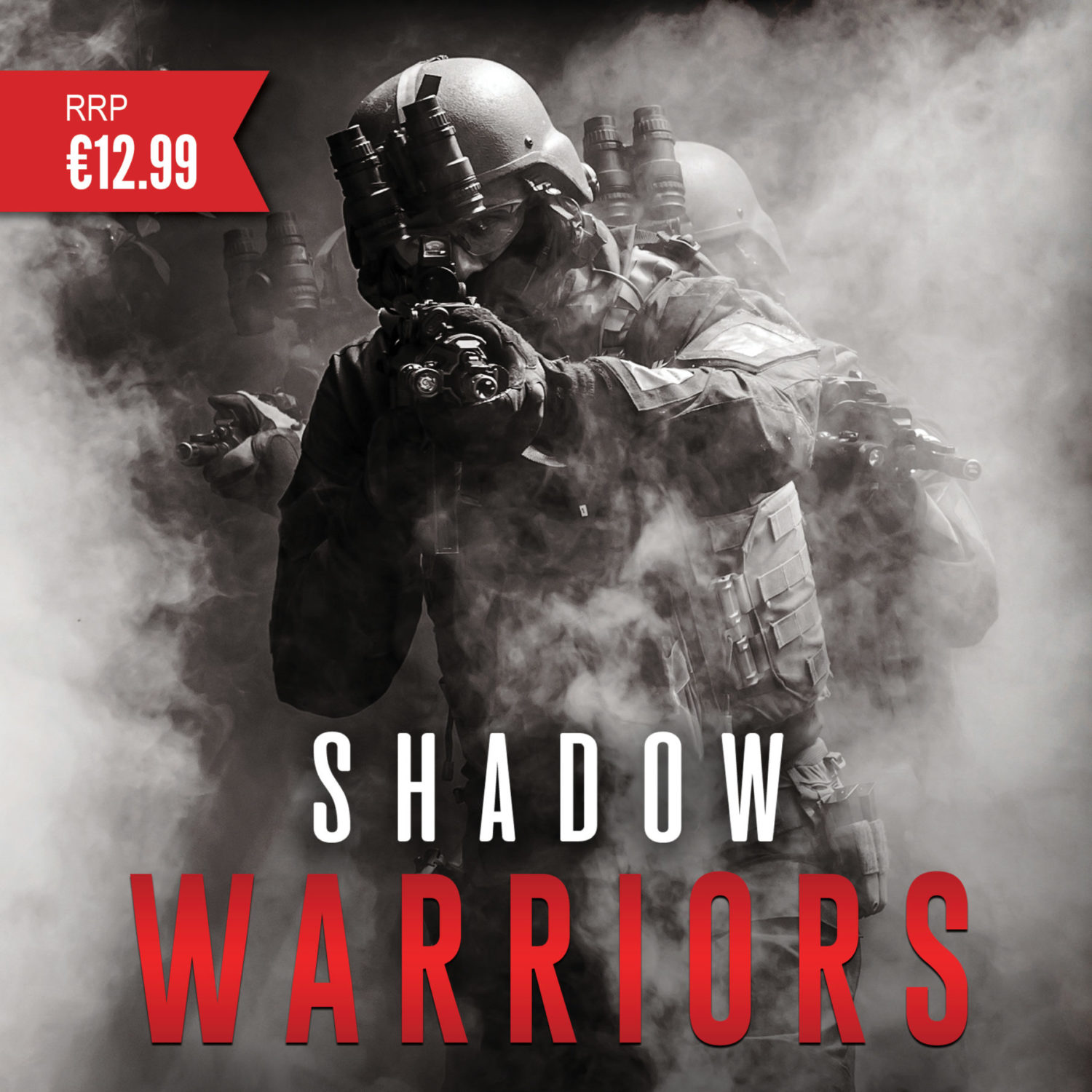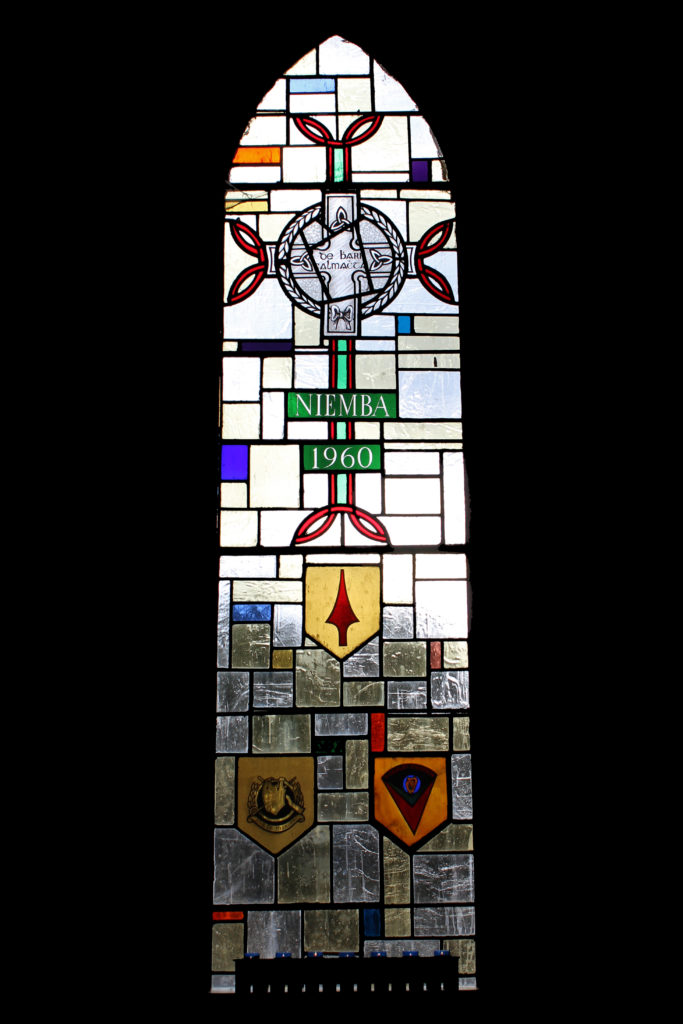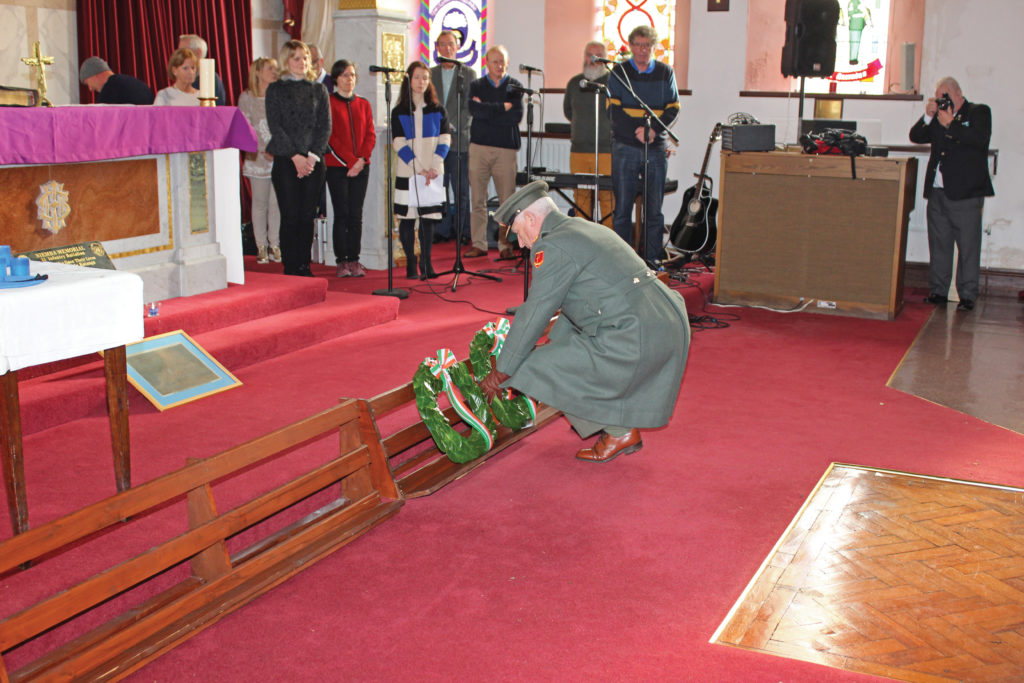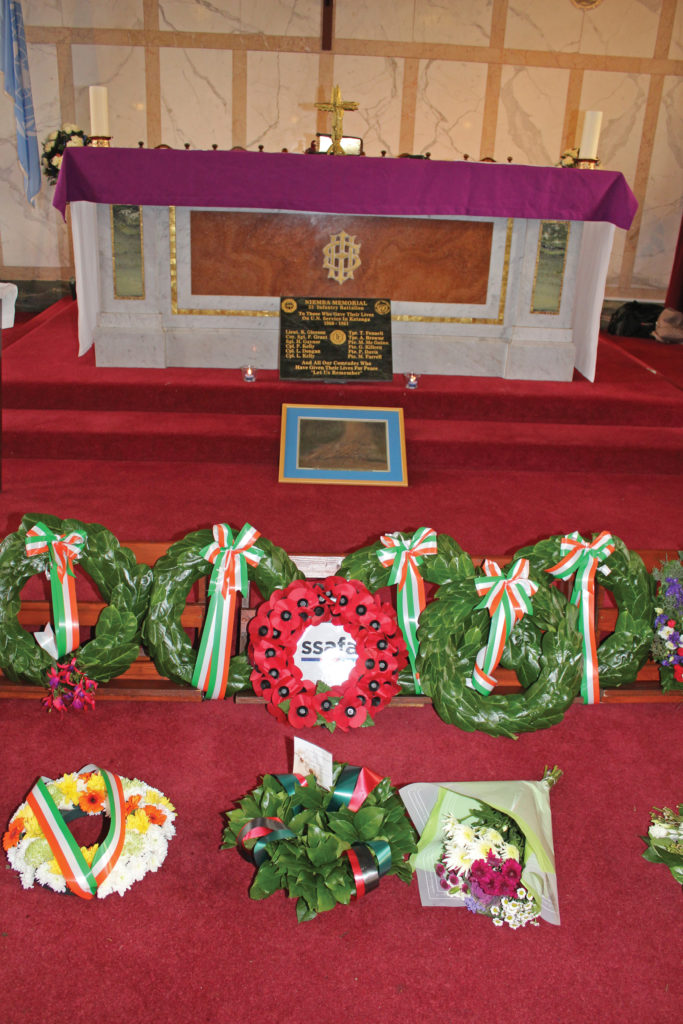An Appreciation of the Niemba Ambush on its 60th Anniversary – By Sgt Wayne Fitzgerald
“The UN ‘blue helmets’ are literally on the front lines in conflicts that are the worst of the worst: protecting civilians, monitoring cease-fires, clearing minefields, and disarming combatants…” – US Senator Joe Biden, now the 46th President of the United States of America
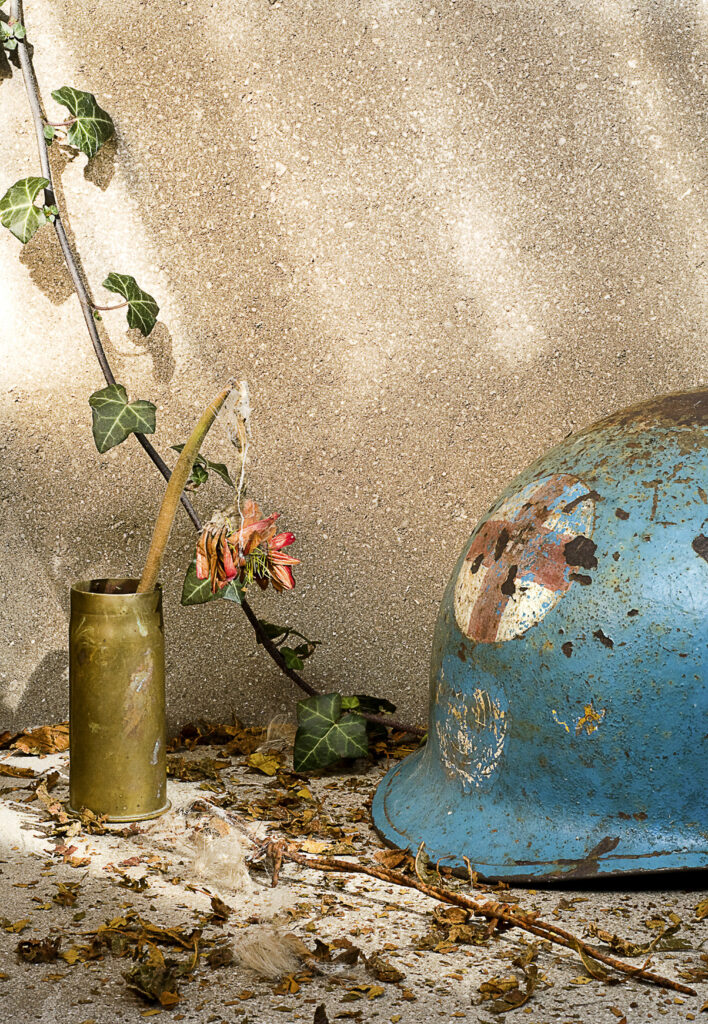
We would normally meet and celebrate the memory of our fallen comrades at Niemba at this time, but not this year unfortunately due to Covid-19 restrictions – which in itself has brought tragedy and grief to too many families in Ireland and around the world to dismiss.
Every year we gather in Cathal Brugha Barracks to lay wreaths in memory of those that died in the Niemba Ambush in 1960 – the event is organised by the Organisation of National Ex-Service Personnel (ONE) along with the logistical support of the 7 Infantry Battalion. The event is always attended by large numbers including the Lord Mayor of Dublin, Defence Forces General Staff, military attachés along with representatives from RACO, PDFORRA, RDFRA, ONE, IUNVA, ARCO, and other smaller veterans’ associations, Congo veterans and the family members of deceased Congo veterans. It is truly a solemn occasion and one I’ve attended with great respect and interest as editor of An Cosantóir: The Defence Forces Magazine over the last number of years.
“The UN has over 100,000 Peacekeepers on the ground, in places others can’t or won’t go, doing things others can’t or won’t do. Peace, like war, must be waged.” – George Clooney
After nearly a century of Belgian rule, the Belgo-Congolese Round Table Conference took place in Brussels from January 29th to 20th February 1960 with the date for Congolese independence set for 30th June 1960. The Congo faced a period of civil unrest up to this date.
In April 1960 the first-ever Irish peacekeepers who served with United Nations Observation Group In Lebanon (UNOGIL) were awarded their UN medals by An Taoiseach Seán Lemass. This was a great first for the Defence Forces and the start to a peacekeeping tradition that has been unbroken for the next 62 years.
When the Congo gained independence on June 30th, they held free elections with Patrice Lumumba being named as prime minister and Joseph Kasavubu as president. On July 5th, the states’ gendarmerie and military ‘Force Publique’ (later retitled as the Congolese National Army or ANC) mutinied demanding a pay rise and the sacking of their Belgian officers. This resulted in Belgian troops intervening to protect Belgian civilians and to put down the mutiny. The newly formed Congo government sacked its Belgian General Janssens and appointed Victor Lundala a sergeant major as their new commander-in-chief.
At this time the mineral-rich province of Katanga declares its independence under the leadership of Moise Tshombe along with the support of Belgian companies and around 6,000 Belgian troops. On July 12th the new government of Lumumba and Kasavubu sought armed UN intervention to prevent a civil war and called on Belgium to withdraw her troops.
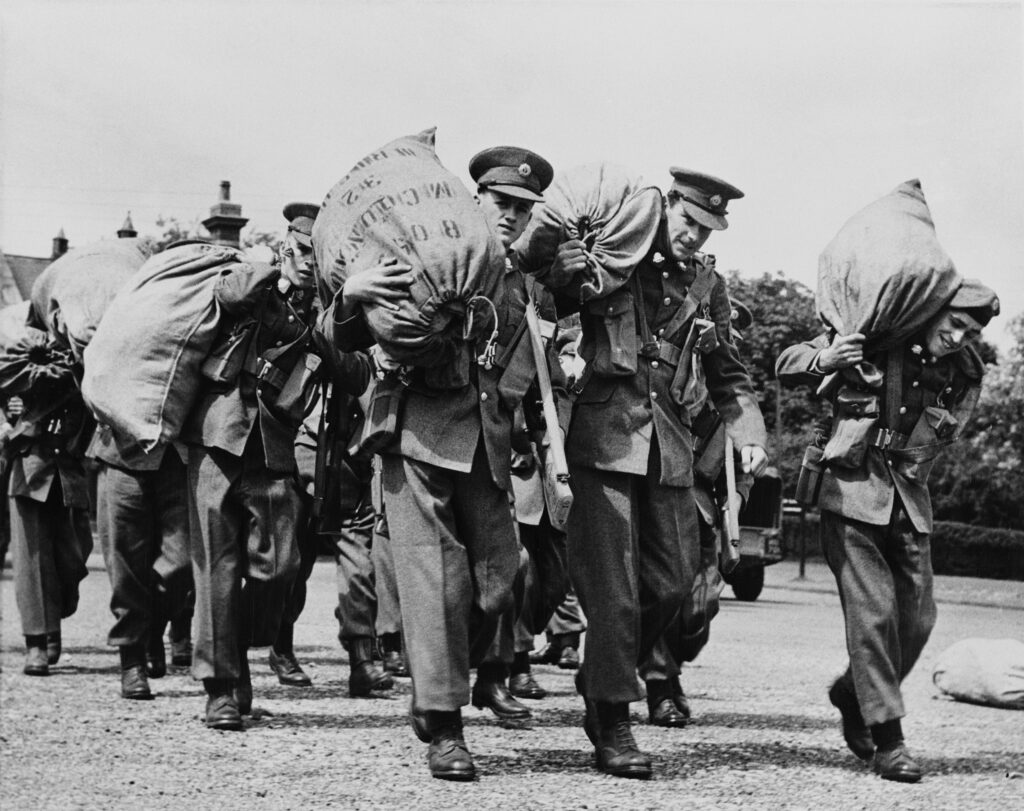
Three weeks later on July 19th, the Irish Government accedes to a request from the UN Security Council to send an Irish Infantry Battalion to Opération des Nations Unies au Congo (ONUC) or in English the United Nations Operation in the Congo. To glorious applause and show of support to their countrymen, the 32 Inf Bn paraded down a packed O’Connell St., passing the historic GPO. On July 27th the US Airforce airlifted them from Baldonnel Aerodrome to the Congo on their massive Globemaster aeroplanes.
On September 5th, President Kasavubu sacks Lumumba after only 67 days in power and installs Joseph Ileo as prime minister. Shortly after on August 12th, UN troops entered Katanga, with the Belgian troops withdrawing. The Emperor of the Balubas, Albert Kalonji also declares the diamond-rich South Kasai as an independent state.
Within a few short weeks of the 32 Inf Bn departing Ireland, the 33 Inf Bn was dispatched on August 16th to the Congo, this was following a further UN request for more troops. 33 Inf Bn was located in different parts of Albertville, except for A Coy, which was located in Kamina.
Dag Hammarskjold is credited with saying, “Peacekeeping is a job not suited to soldiers, but a job only soldiers can do.”
The Niemba Ambush was the first-time Irish soldiers were involved in a combat engagement since the ending of the Civil War in 1922. And that the Niemba Ambush was, and still remains, the greatest loss of life overseas in a single incident for the Irish Defence Forces.
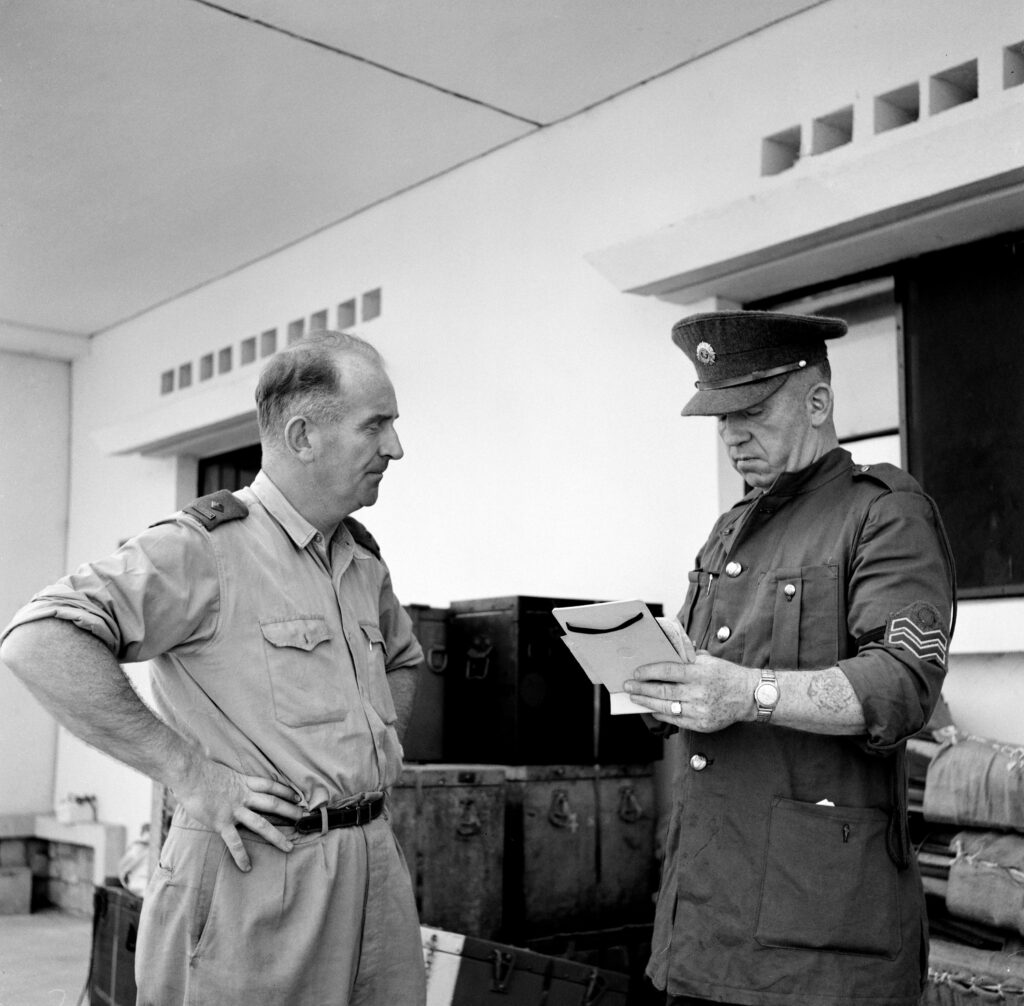
In the weeks leading up to the day of the patrol, there was a heavily armed Gendarmerie mobile platoon consisting of about twenty-seven Congolese and eight Belgians who carried out daily patrols in the Niemba area.
There had been daily clashes and raids between the Baluba tribes and the European mercenaries and the Gendarmerie, resulting in huts and villages being burnt down – It is said that this made the Balubas sceptical of white European soldiers.
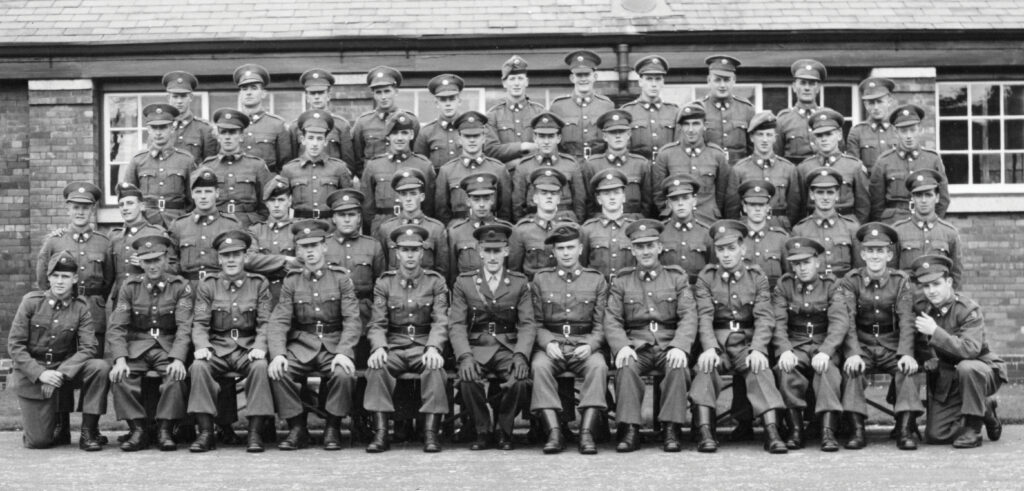
On 8th November 1960, Lt Kevin Gleeson (Terenure, Dublin) commanded an 11-man patrol from No 2 Platoon, A Coy, 33 Inf Bn. Lt Gleeson was assisted by Sgt Hugh Gaynor (Leixlip, Co Kildare), and his NCOs Cpl Peter Kelly (Templeogue, Dublin), and Cpl Liam Dougan (Cabra, Dublin). The rest of the patrol was made up of Pte Matthew Farrell (Swords, Dublin), Tpr Thomas Fennell (Donnycarney, Dublin), Tpr Anthony Browne (Rialto, Dublin), Pte Michael McGuinn (Blackhorse Ave, Dublin), Pte Gerard Killeen (Queen St., Dublin), Pte Joseph Fitzpatrick (Charlemont St., Dublin) and Pte Thomas Kenny (Ballyfermot, Dublin).
Reading the 33 Inf Bn Unit History, Lt Gleeson had patrolled the area of the ambush the day before where they had been out dismantling roadblocks and repairing bridges in the Niemba area of operations. They also found natives armed with bows and arrows who claimed to be Pygmys and not Balubas.
At about 1330 hours on that faithful day, Lt Gleeson’s patrol left as instructed to recce the road south towards Kinsukulu. They travelled in a Land Rover and a Volkswagen pick-up. Lt Gleeson and the three NCOs carried Gustaf machine guns along with Tpr Browne. Privates McGuinn and Fennell carried two Bren Guns, and the rest were riflemen.
An hour and a half into the patrol and having bypassed a few roadblocks, the patrol was stopped as three Baluba tribesmen stood on the road armed with bows and arrows. Lt Gleeson and Sgt Gaynor approached them with local greetings, but they disappeared into the bush. Lt Gleeson ordered the patrol to get out of the vehicles and on to the road. With some patrol members serving in the Engineers at home, they assessed the bridge but found only three planks remained. They would have to rebuild the bridge to cross, so they searched left and right to find an alternative way across the Luweyeye River.
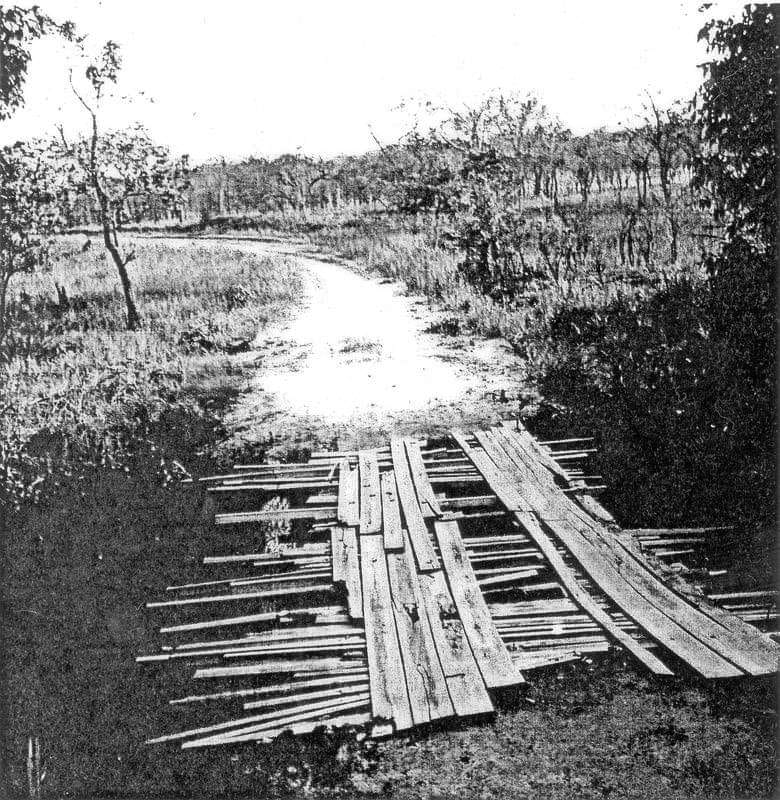
Pte Fitzpatrick was posted at the rear of the vehicles along with Tpr Browne and they could see the Balubas moving about in the bush. Then a large group of approx 40 Baluba tribesmen came out on to the road screaming and shouting at them while heavily armed with clubs, hatchets and their custom bows and arrows. Immediately the Baluba warriors stormed the patrol before they could get the Bren Guns into action and were on top of them before they heard Lt Gleeson’s order to ‘open fire’. The patrol had to fight a rear-guard action and make their way across the river and on to the other bank. Many of them had received wounds from potentially poison-tipped arrows. The patrol members were all dispersed in the tall bush grass but were picked off and ferociously attacked by the Baluba tribesmen.
Tpr Browne having survived the initial attack broke cover and fired his Gustaf machinegun, he is thought to have escaped but later killed, as his body was not found until two years later.
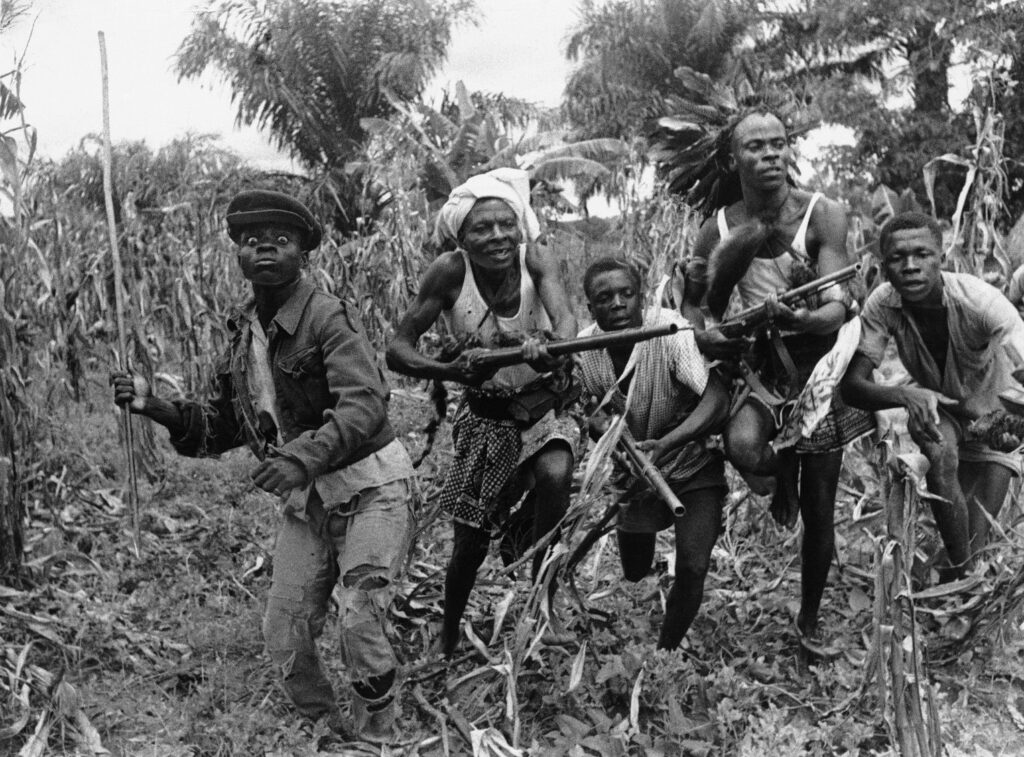
The only two peacekeepers to survive the ambush were privates Fitzpatrick and Kenny, who were very fortunate to escape with their injuries. They hid and wandered in the wild bush separately for hours before they were pickup by Irish patrols sent out to find Lt Gleeson’s patrol who had missed their check-in and failed to return.
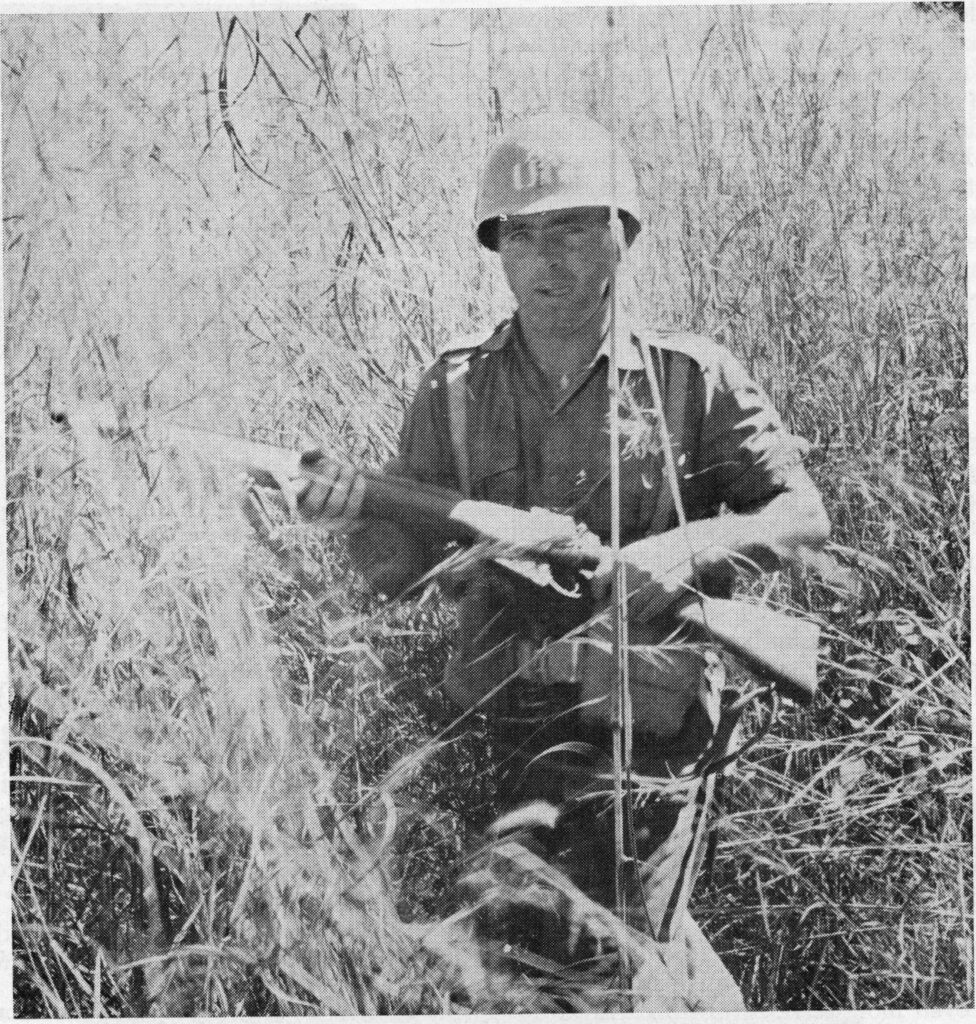
It is believed that the Baluba tribesmen thought they were attacking European mercenaries who were hired by the breakaway Katanga province. The Baluba tribe had not supported the secession. It is said that the small Irish patrol who were trying to keep the bridge over River Luweyeye open, had killed and wounded a large number of the attacking Baluba tribesmen.
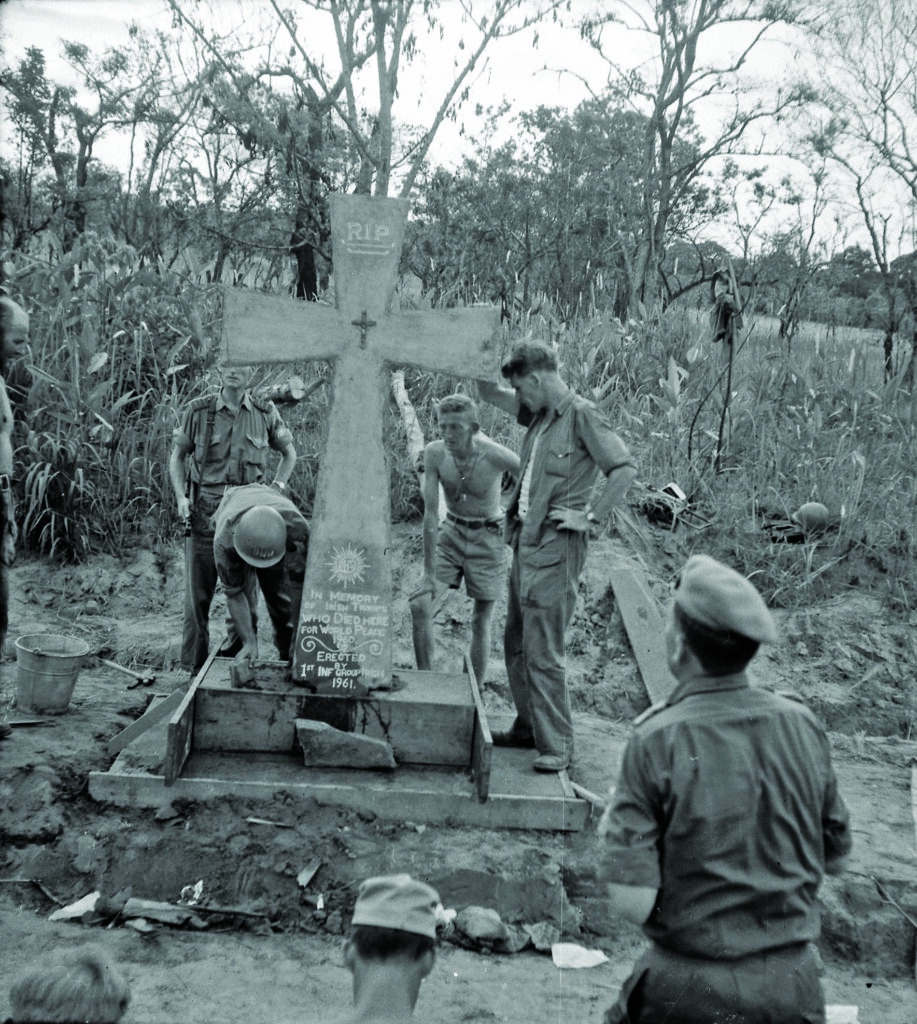
The nine remains were flown home to Baldonnel, where they laid in state before a large funeral procession back through the streets of Dublin, before the funeral in Glasnevin Cemetry. Thousands of silent mourners turned out to acknowledge the sacrifices these Irishmen had paid for the cause of world peace in a country nearly seven thousand miles away.
On 8th November 1961, a year to the day, the then Irish President Éamon de Valera unveiled a plaque in Arbour Hill Church to those Irish peacekeepers who were killed in Niemba. An Taoiseach, Seán Lemass presented the only medal awarded to Lt Gleeson’s patrol – An Bonn Míleata Calmachta or The Military Medal for Gallantry (MMG) with Distinction, which was posthumously presented to Mr John Browne, father of 20-year-old Tpr Anthony Browne, from Rialto, Dublin.
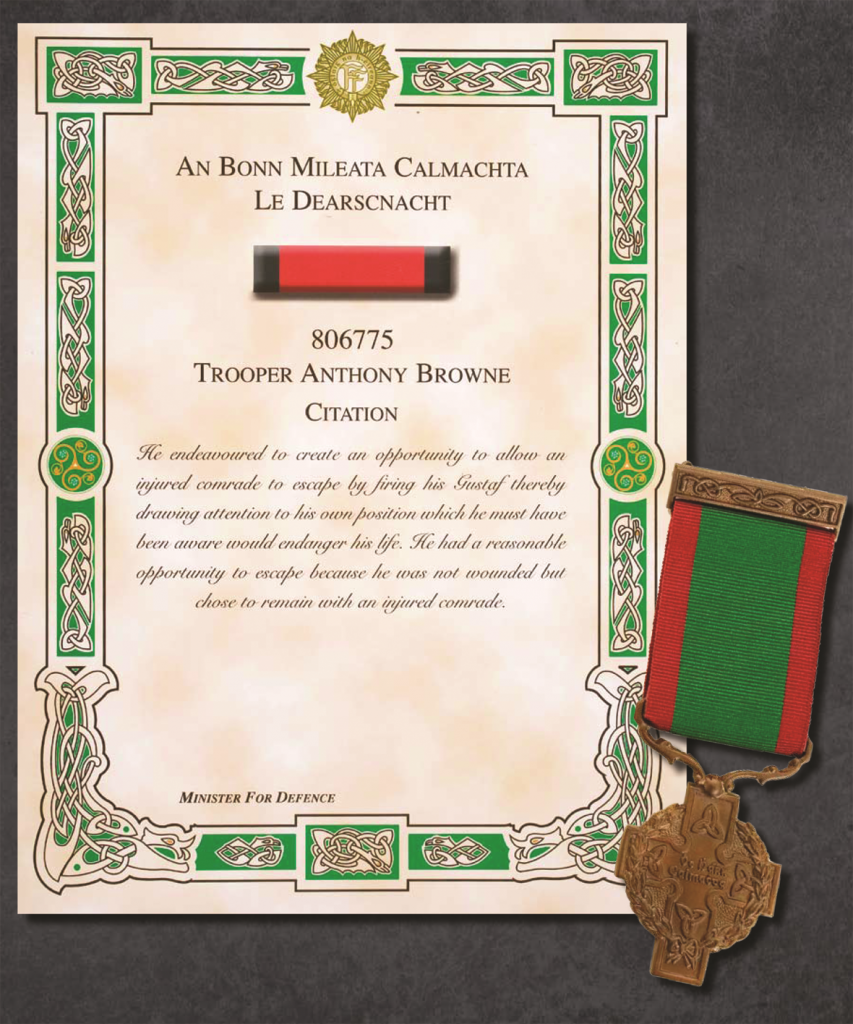
Tpr Browne was awarded his MMG for the heroic actions he showed during the ambush, where his citation reads, “He endeavoured to create an opportunity to allow an injured comrade to escape by firing his Gustaf thereby drawing attention to his own position which he must have been aware would endanger his life. He had a reasonable opportunity to escape because he was not wounded but chose to remain with an injured comrade.” This is the highest award and the only MMG given out of the 60 plus medals awarded to over 6,000 Irish peacekeepers who served in the Congo in a four-year period from 1960-1964. 26 Irish peacekeepers died while serving in the Congo.
In the recorded history of the 33rd Inf Bn held in Military Archives, the unit OC Lt Col R. W. Bunworth opens with, “I cannot omit mention of our great tragedy at Niemba. This will always be our special memory, a memory made poignant by the knowledge that the small and ill-fated patrol were only carrying out to the best of their ability, the role of keeping the peace in a country torn, especially in the area of 33 Infantry Battalion, by civil war.”
In the unit history, he mentions that the 33 Inf Bn were, “soon to realise the very considerable difference between the peacetime, barrack life at home in Ireland and the active service type of operation with UN in Congo.” Citing lack of experience, and the difficulty for all of them “to visualise what a UN peacekeeping mission entailed,” when they were equipped and trained in the traditional infantry weapons yet restricted in their use by the, “well-known and accepted UN policy of avoiding the use of force.”
“Peacekeeping is a soldier-intensive business in which the quality of troops matters as much as the quantity. It is not just soldiering under a different colour helmet; it differs in kind from anything else soldiers do. There are medals and rewards (mainly, the satisfaction of saving lives), but there are also casualties. And no victories. It is not a risk -free enterprise.” ― Larry Wentz, contributing Editor ‘Lessons From Bosnia: The IFOR Experience’
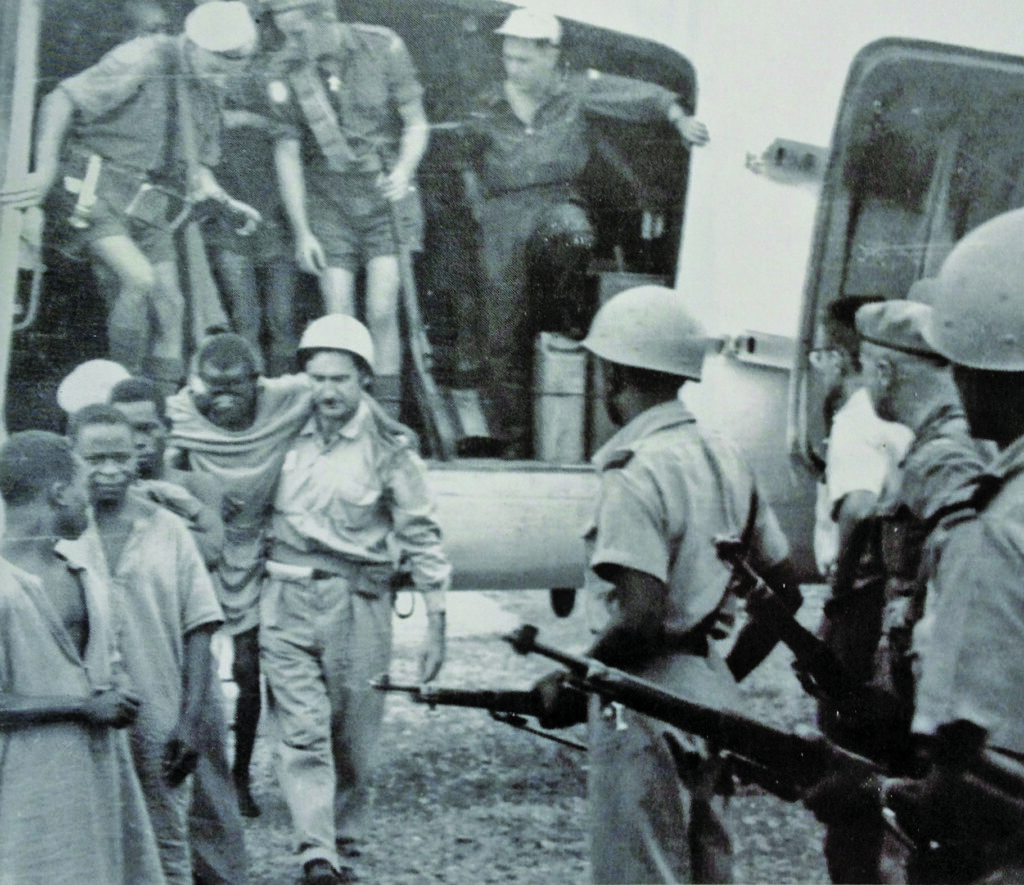
There is more to this engagement that might bring some closure. On 30th November 1960, ‘Operation Shamrock’ took place, this was a secret mission by members of B Coy 33 Inf Bn to raid the Manono Hospital for the wounded Baluba tribesmen involved in the Niemba Ambush. Five wounded Balubas were detained and brought to trial in Elizabethville in September 1961. The trial was adjourned for a while as the city was the under bitter fighting between UN and Katanga forces. The trial resumed on 12th October 1961 and proceeded with a conviction. According to the 33 Inf Bn’s unit history, that on Monday 13th November 1961, the five Niemba men accused, were found “guilty of murder and attempted murder, without pre-meditation, as well as the offence of carrying arms in an insurrectionist movement. Two of the accused were sentenced to three years’ penal servitude. The other three received sentences of two years penal servitude.” Operation Shamrock was explained in more detail by Des Keegan (IUNVA) in July-August 2018 issue of An Cosantóir.
On 26th June 1963, the US President John F Kennedy praises Irish UN peacekeepers during his visit to Ireland:
“The major forum for your nation’s greater role in world affairs is that of protector of the weak and voice of the small, the United Nations. From Cork to the Congo, from Galway to the Gaza Strip, from this legislative assembly to the United Nations, Ireland is sending its most talented men to do the world’s most important work – the work of peace.
…like the wild geese after the Battle of the Boyne, you are not content to sit by your fireside while others are in need of your help. Nor are you content with the recollections of the past when you face the responsibilities of the present.
Twenty-six sons of Ireland have died in the Congo; many others have been wounded. I pay tribute to them and to all of you for your commitment and dedication to world order. And their sacrifice reminds us all that we must not falter now.
Ireland’s influence in the United Nations is far greater than your relative size.
I speak of these matters today not because Ireland is unaware of its role, but I think it important that you know that we know what you have done, and I speak to remind the other small nations that they, too, can and must help build a world peace.
My friends, Ireland’s hour has come. You have something to give to the world, and that is a future of peace with freedom.”
In 2006, the then Irish Minister for Defence Mr Willie O’Dea is quoted by The Irish Times as saying he wholeheartedly recognised and acknowledged that “both Pte Kenny, particularly in view of the serious wounds and injuries he sustained and Pte Fitzpatrick survived a horrific encounter with hostile forces, displaying courage, fortitude and tenacity in order to survive until finally rescued.” He commended them both, “for the selfless service they have given their country.”
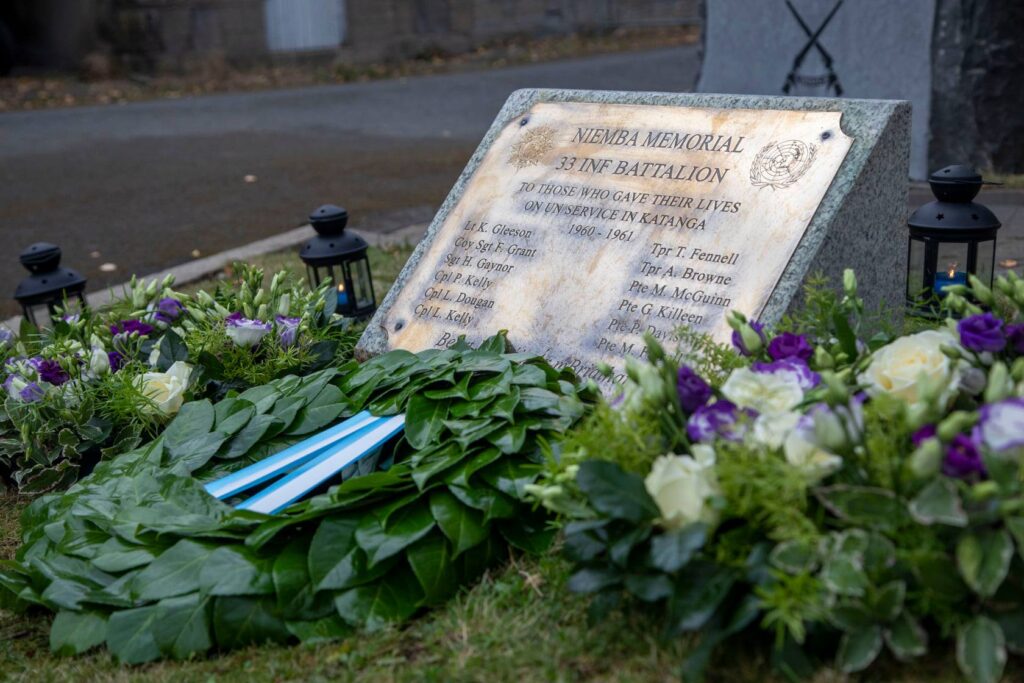
On Saturday 7th November 2020, the 60th Anniversary of the Niemba Ambush was commemorated in a closed ceremony in Cathal Brugha Barracks. Wreaths were laid by Brig-General Tony Cudmore, GOC 2 Bde, and the National Chairman of ONE Brig-General Colm Campbell retired. They were accompanied by CQMS Michael Colton retired, who is the Honorary President of Post 1, Irish United Nations Veterans Association (IUNVA). CQMS Colton was also a member of the 33 Inf Bn and was one of those selected to escort the remains of those killed-in-action home.
Blessed are the peacemakers, for they will be called children of God. Matthew 5:9
